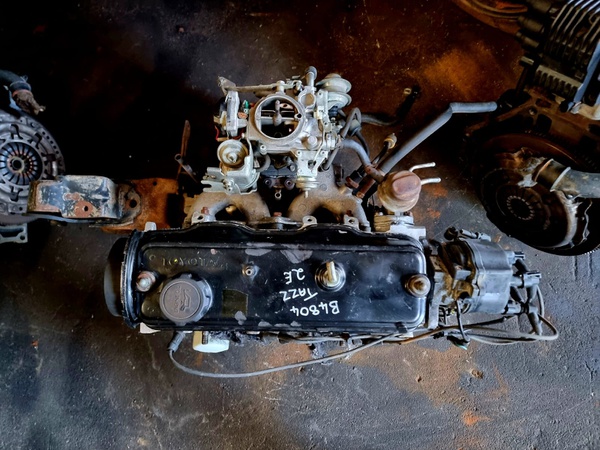Toyota Tazz: Exploring Its Legacy and Continued Appeal Among Drivers
Toyota Tazz: Exploring Its Legacy and Continued Appeal Among Drivers
Blog Article
Discover the Most Current Patterns in Engine Technology Through Tazz
In the rapidly progressing landscape of vehicle modern technology, Tazz stands at the forefront, highlighting substantial improvements in engine systems that prioritize both technology and sustainability. tazz. From crossbreed engines that optimize gas efficiency to the introduction of hydrogen fuel cells, the fads shaping modern powertrains are not just boosting efficiency however likewise attending to vital ecological challenges. As the industry continues to push boundaries, it is necessary to take into consideration just how these developments will influence future transport remedies and the more comprehensive effects for global energy consumption. What exists in advance in this essential change?
Crossbreed Engine Innovations
Hybrid engine technologies stand for a pivotal change in automobile technology, incorporating the benefits of inner combustion engines with electrical propulsion systems. This combination not only improves fuel performance but additionally decreases exhausts, meeting significantly strict ecological policies. By making use of both energy resources, hybrid engines can optimize efficiency, supplying power when needed while preserving fuel during much less demanding driving problems.
Recent improvements in hybrid innovation consist of improvements in battery effectiveness and regenerative stopping systems. These innovations permit better energy healing throughout deceleration, which can be redirected to help in velocity or power auxiliary systems. Manufacturers are focusing on lightweight products and portable layouts to optimize the performance of crossbreed powertrains.
The development of plug-in hybrids has also expanded the market, allowing chauffeurs to bill their automobiles making use of typical electric outlets. This feature frequently allows for considerable all-electric range, additional decreasing dependence on conventional fuels. tazz. As the automobile industry continues to evolve, hybrid engine technologies are anticipated to play an essential role in bridging the gap in between standard automobiles and completely electric models, providing a transitional solution that accommodates diverse customer demands and preferences
Breakthroughs in Electric Powertrains
The auto landscape is quickly developing, with electrical powertrains arising as a leading force in sustainable transport. Advances in electric vehicle (EV) innovation are dramatically enhancing user, efficiency, and effectiveness experience. Key technologies consist of improvements in battery chemistry, which have actually enhanced power thickness, reduced billing times, and extended total battery life.
Solid-state batteries, as an example, assure to reinvent the market by supplying higher safety and performance compared to standard lithium-ion cells. Additionally, advancements in regenerative braking systems are making it possible for cars to recoup energy throughout slowdown, adding to total efficiency.
In addition to battery modern technology, electric motor designs are ending up being more advanced. Technologies such as integrated motors and advanced thermal administration systems are aiding to optimize power delivery and decrease weight, inevitably boosting vehicle dynamics.

Jointly, these breakthroughs emphasize the dedication to shift towards cleaner, more efficient transport remedies, placing electric powertrains at the forefront of automotive innovation.
The Surge of Hydrogen Gas Cells
Progressively, hydrogen fuel cells are gaining grip as a feasible option to typical inner burning engines and battery electrical cars. This technology utilizes the chemical power stored in hydrogen, converting it into electrical power with an electrochemical reaction with oxygen. The key byproduct of this procedure is water, making hydrogen fuel cells an eco-friendly alternative with absolutely no discharges at the tailpipe.

Automakers are progressively purchasing hydrogen gas cell technology, recognizing its capacity for long-range applications and fast refueling capacities that rival conventional fuels. Furthermore, markets such as durable transportation and public transportation are specifically fit for hydrogen gas cells, where battery electrical solutions may fail due to weight and range limitations.
As research and investment remain to expand, hydrogen fuel cells are poised to play a significant role in the future landscape of tidy transport and power remedies.
Enhancements in Internal Combustion Engines
Developments in interior combustion engine (ICE) technology are transforming traditional vehicles to fulfill modern-day ecological requirements and performance expectations. One of one of the most substantial improvements includes the integration of advanced gas shot systems. These systems enhance the air-fuel mix, improving burning effectiveness and leading to decreased emissions. Straight More Info fuel injection, for example, permits much better atomization of fuel, bring about even more total burning and boosted power outcome.
Additionally, turbocharging has actually acquired prestige, enabling smaller sized engines to deliver greater performance without the weight of bigger engines - tazz. This technology not just boosts performance but additionally adds to reduce gas usage. Variable shutoff timing systems are also being improved, enabling engines to adjust to numerous driving conditions for boosted torque and responsiveness
Furthermore, making use of lightweight materials in engine building and construction is becoming typical, further improving gas efficiency by minimizing total car weight. Engine control systems (ECUs) are significantly sophisticated, allowing real-time changes that optimize performance and discharges.
These improvements collectively represent an essential change in ICE technology, aligning with worldwide sustainability objectives while still giving the performance chauffeurs get out of their automobiles. As the sector evolves, these improvements continue to shape the future of standard auto design.
Future Trends in Engine Efficiency
Significant developments in engine effectiveness are expected as makers concentrate on incorporating sophisticated modern technologies to fulfill rigorous ecological regulations and customer needs. The change towards electrification, hybrid systems, and alternate fuels is reshaping the automotive landscape, driving innovations that enhance gas economic situation and lower emissions.
One of the essential fads is the application of sophisticated materials and making techniques. Lightweight composites and high-strength alloys contribute to minimized lorry weight, therefore boosting overall performance. In addition, the adoption of turbocharging and variable shutoff timing technologies enables for improved power outcome from smaller sized engines, further boosting gas economy.

Verdict
Finally, the expedition of engine technology exposes significant improvements that focus on sustainability and effectiveness. Technologies in hybrid engine systems, electrical powertrains, and hydrogen gas cells demonstrate a dedication to reducing discharges while boosting performance. Enhancements in inner combustion engines and a focus on lightweight products add my link to overall engine efficiency. As the vehicle sector continues to develop, these patterns will certainly play a crucial function fit a cleaner and even more lasting future for transport.
From crossbreed engines that maximize gas performance to the appearance of hydrogen gas cells, the fads forming modern-day powertrains are not just boosting efficiency yet additionally resolving essential ecological obstacles.Crossbreed engine technologies stand for an essential change in vehicle innovation, integrating the benefits of internal burning engines with electrical propulsion systems.In addition, turbocharging has gained prestige, permitting smaller sized engines to provide higher performance without the weight of bigger engines. In addition, the adoption of turbocharging and variable valve timing technologies permits for boosted power outcome from smaller engines, further boosting fuel economy.
Improvements in inner combustion engines and a focus on light-weight materials contribute to total engine effectiveness.
Report this page